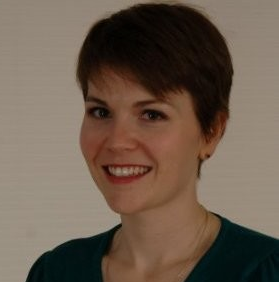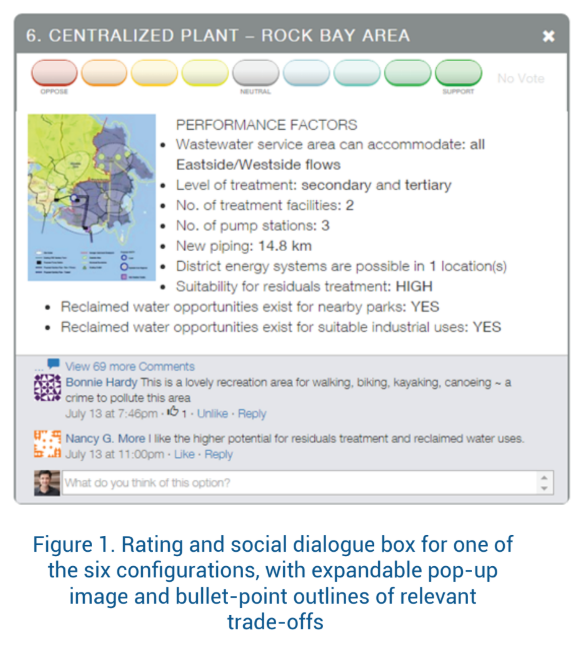

Engaging residents in the location of a new waste treatment plant
The Capital Regional District of British Columbia, Canada used Ethelo to bring full-transparency to an heated decision around the location for a wastewater treatment plant. Local citizens and governing bodies needed to resolve the diversity of needs of tax-payers, activists, and municipal administrators. After evaluating 6 potential locations and different technologies, the CRD screened out locations with low public acceptance, narrowing down on one general site.
6 site
options
>1000
participants

Communications Coordinator, CRD

Citizens were able to consider these trade-offs as they scored each site against the two criteria..
The six areas were presented in random to each user, to guarantee greater objectivity. In addition to quantitative criteria-based
Figure 1. Rating and social dialogue box for one of the six configurations, with expandable pop-up image and bullet-point outlines of relevant trade-offs evaluations, participants were also able to comment and respond to comments on the locations. This attracted significant dialogue as people responded and liked each other’s contributions.
Due to the controversial nature of the project, and the real property interests of many participants, the CRD also needed to ensure confidence that the results could not be compromised by some participants voting multiple times, and similar sources of bias.
Ethelo achieved this confidence by a process of “passive authentication.” Participant information was tracked by asking the public for their unique email address in order to sign up and/or log in. This was only part of the process however. In order to arrive at accurate results by avoiding false or double votes, Ethelo ran the final data through a filtering process. This included applying the following criteria, which flagged (and eventually eliminated) suspect votes;
“High risk” submissions were defined as submissions flagged with two or more filtering of 56 votes were filtered out, representing 5.1% of the original vote population. The filtered results were also compared against the non-filtered results. The preferred location remained the same before and after the filtering (i.e., Centralized Plant – Rock Bay Area)Criteria-based evaluation and dialogue.
Citizens were able to consider these trade-offs as they scored each site against the two criteria..
The six areas were presented in random to each user, to guarantee greater objectivity. In addition to quantitative criteria-based.
Each citizen had the opportunity to assess the potential locations according to both siting and performance criteria, and then weight those criteria to identify their personal top choice .Ethelo aggregated this information using several analytic techniques to identify for decision-makers which path of action would receive the strongest “strength of support”. To the wastewater treatment situation itself, predominantly around issues of costing, siting, treatments levels, and the overall consultation process. Overall, the high completion rates (84%) show that Ethelo was an effective conduit for socializing and interpreting citizen opinions.
The participants’ engagement level varied according to age-groups and municipalities. People older than 55, and those responding from districts in the municipality of Victoria, demonstrated the highest levels of participation.
More than 1,000 people voted and/or commented over a three week period, providing almost 1,100 comments and significant insight and clarity into public sentiment. 292 citizens contributed a total of 787 comments on the 6 areas under evaluation, averaging 131 comments per area.
In addition, 309 general comments were registered through the general feedback panels, out of which 27 (9%) dealt directly with Ethelo platform’s functionality – either positively
(6; 22%), critically (9; 33%), or asking/adding clarification or making a technical suggestion (12; 45%). The remaining comments pertained.
The CRD wanted citizens to experience a fully- transparent process from start to finish. Besides the social media discussion around each option and criteria, the final results were open to the public. This allowed participants to have a clear sense of the overall public sentiment around each of the six proposed solutions. In turn, Ethelo’s ‘strength score’ reflected the depth and breadth of collective support for a given scenario; which is based on two variables:
The CRD was on a tight deadline, leaving little time to pilot test the platform. This represented a major learning opportunity for Ethelo, allowing our team to receive public feedback on issues such as: perceived lack of anonymity when providing emails; importance of re-framing/ clarifying the language of the landing page; amount of information to make a decision (too much, or too little); forced choices in some survey questions; taking more than the 3-5 minutes specified in the landing page; etc. These issues were addressed directly, and resolved or clarified within 1 or 2 working days.
The Ethelo engagement was only one stage of a multi-stage decision-making process. The two locations identified by Ethelo as having the highest ‘strength of support’ were sent for review by the the CRD’s Waste Management Committee, and then sent to an independent panel of experts for a detailed costing and engineering analysis. The results of that independent review were published in September 2016.

“I have never worked with a public engagement tool like Ethelo before and I am pleased to have had the opportunity. You and your team was very helpful and I appreciate the long nights I imagine you had to spend to make this happen.”
Kristin Quayle